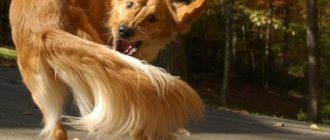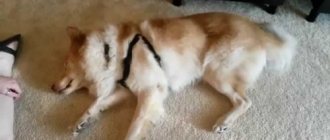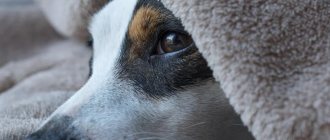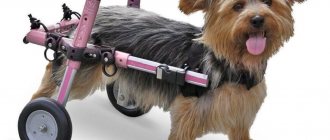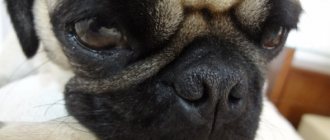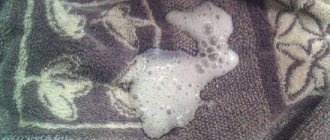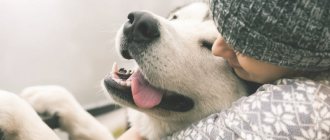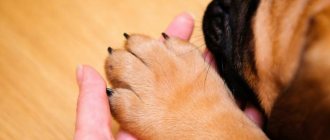Dogs of this breed, such as pugs, were bred in China.
The height of these friendly four-legged friends is 30-36 cm if we are talking about a male, and 25-30 cm when we are talking about a female. As you can see, these are quite miniature animals.
Pugs live from 12 to 15 years. This breed of dog is perfect for keeping in urban environments.
And even those dog lovers who do not have extensive experience in caring for animals will be able to cope well with caring for pugs and become excellent pet owners.
However, in some cases, these kind and friendly creatures begin to lose their eyes.
Within the framework of today's topic, we will talk about why the eyes of this breed of dog can fall out, how to detect this phenomenon at the initial stage and provide first aid to your pet in such a situation.
Causes of eye loss
Experts cite the structural features of the skull in these animals as the first reason for such an unpleasant and very serious disease.
It is worth noting that pugs, along with some other dog breeds, belong to the category of four-legged animals that are scientifically called brachycephalic . By the way, such dogs need a special muzzle.
Such animals are distinguished by characteristic anatomical features. This may include the presence of some problems with the respiratory system, increased salivation, as well as poor protection of the eyeballs.
If you look at a pug from the outside, you can say that in fact the eyes of this pet are protected exclusively by eyelids.
In this regard, eyeballs can begin to fall out even with minor injuries or improper care and maintenance of the animal, as well as with sudden movement, stress, a weakened immune system, and even in the case of chronic constipation.
CAREFULLY!
The likelihood of eye loss increases several times as the animal ages, which is explained by the deterioration of tissue elasticity.
At the same time, in practice it is possible to observe both the loss of one of the eyes and both at the same time.
How to understand that a dog has proptosis
In fact, it is difficult to confuse proptosis with other diseases. Even the appearance of the pet will indicate this. In addition to apples falling out of the orbit, the following symptoms indicate proptosis:
- the membrane of the eyeball, which has fallen out, is swollen and inflamed;
- there are also hemorrhages on it;
- the cornea acquires an opaque dark color;
- a hematoma forms in the periocular area.
Diagnostic methods
It is hardly possible to confuse such a state with something else.
If something like this happens to a pet, you can first understand it by its unaesthetic appearance.
In the process of moving attention between objects or people, the animal’s eyes will clearly stand out against the background of the muzzle.
In addition, it will be possible to observe the inflammatory process, redness of the eyes, as well as burst blood vessels. Against the backdrop of all the processes taking place, the appearance of the animal will be distinguished by soreness.
Character
The main character traits of pugs are friendliness and calmness. These cute dogs are unobtrusive and balanced. Most of the time they just sleep. They love to do this next to their owner on the couch.
But only adult dogs are lazy, and even then, they are always ready to play. Pug puppies are energetic and playful. They are cheerful, active, chasing leaves or snowflakes. Up to 2-3 years old, pugs love to frolic. But gradually they become more calm and restrained.
They are affectionate and loyal, they get very bored without their owner, so it is not advisable to leave one pet for a long time. These dogs are friendly with all family members. Warm feelings are shown by caressing and wagging the tail, even towards guests and strangers. This can lead to problems, so you immediately need to teach the dog not to obey strangers and not to take food from their hands.
Photo of a pug
The pug is a good companion for people of any age. He is able to amuse with his mischievous antics and funny facial expressions, and brighten up the loneliness of an elderly person. They are bad guards, but still the pet will always warn the owner about the arrival of a guest with his barking. And if someone threatens family members, he will bravely rush to defense.
One of the characteristics of the breed is that these dogs love children. The pug will become a devoted friend and nanny for the child, accompany him everywhere and tolerate his pranks. But it is worth keeping an eye on their play so that the baby does not injure the pet.
Another characteristic of the Pug breed is its stubbornness and perseverance. They are smart and quick-witted, so they easily show their owner what they want. For this same reason, they can be difficult to train, especially as adults. This dog may refuse to follow a command if it is offended, tired or believes that it does not need it.
First aid
It is quite natural that if such a situation happens for the first time, the animal’s owners may be confused, not knowing what to do in the current circumstances.
In such a case, there is no need to panic.
Pug owners should always ensure that the simplest saline solution is always present in their home medicine cabinet..
It is unlikely that you will be able to do without this remedy if, for example, a speck gets into your pet’s eye.
Fixing the eyeball in the correct position will not be difficult.
To do this, you will need clean gauze, which should be folded several times and thoroughly wetted with the solution . Afterwards, the moistened gauze cloth should be applied to the missing eye and securely secured with a bandage.
If it happens that there is no gauze or solution available, then you can use a clean handkerchief.
A handkerchief should be moistened in salt water and also applied to the prolapsed eyeball. After these steps are completed, you should take the animal to the veterinarian, who will be able to correctly return the eye to its original place.
NOTE!
After such manipulations, the four-legged friend’s eye should be bandaged until complete recovery.
Sometimes the veterinarian is forced to stitch the dog's eyelid shut. After an appropriate period of time, the applied sutures are removed.
In order to speed up the healing process, experts recommend treating the pug's eyes with saline solution, and also using hydrocortisone ointment for this..
It is quite possible to put the eye back in place without the help of a doctor. To do this, you should first wash your hands with soap, then gently press your finger on the apple of your eye, which will allow you to return it to its place.
Then you need to moisten the animal’s eyelids and apply a sterile bandage.
If first aid is provided incorrectly or is absent, the dog’s visual organ may atrophy.
As for veterinarians, they recommend not postponing your pet’s visit to a specialist if such a problem arises.
Expert opinion
Tolkachev Andrey Mikhailovich
veterinarian
“Depending on existing opportunities, you should not put off a visit to the veterinarian for a long time. This is due to the fact that if first aid is not provided in a timely manner, then, as experience shows, the pet may become blind. At home, it is unlikely that anyone will be able to provide adequate first aid. All this is fraught with drying out of the eye and the development of an inflammatory process, which may require longer and deeper treatment.”
Cysts, adenomas and adenocarcinomas of the sebaceous glands
Sebaceous cysts are common types of skin cysts that contain sebum, a thick, oily material typically found in the skin around hair follicles.
These formations can be on any part of the body. Sebaceous cysts are benign, but they can also be mistaken for a malignant tumor called sebaceous adenocarcinoma or a benign growth called sebaceous adenoma.
If the cyst is not bothering your dog, your veterinarian can leave him alone, but if necessary, the cyst can be removed surgically.
Once removed, the cyst should be sent to a laboratory so that a veterinary pathologist can determine that it is indeed just a sebaceous cyst, adenoma, or adenocarcinoma, which may require additional treatment.
Pathology treatment methods
It should be noted that there are no specific therapeutic treatments for eye loss in pugs.
In such a situation, the dog will undergo surgery, during which the missing eye will be returned to its place.
This type of surgery is performed under general anesthesia and consists of the following steps::
- removing contaminants by washing the eyes;
- injection of a hydrocortisone solution and dissection of the resulting adhesions of the eyelid;
- returning the missing eye to its place;
- application of antibacterial ointment and fixing bandage.
After surgery, the animal must be given antibiotics . After a week, the visual organ is re-treated.
Only the veterinarian will determine the final time for removing the fixing bandage.
The eye muscles recover completely within a few months (shown in the photo). Sometimes what happens is that the dog's optic nerve is completely severed. In this situation, the animal's eyeball is completely removed.
In certain cases, when the integrity of the internal eye muscle is compromised, the dog may develop strabismus or neuritis.
Prognosis for recovery
It is difficult to predict how proptosis will end in your pug - the outcome is individual for each dog. But remember that eye displacement itself is not a death sentence! The final outcome is influenced by complications of the condition due to additional injuries and infections.
In the best case scenario, the dog’s eye can be restored and his vision can fully return. In some cases, when the integrity of the eye muscle is damaged, vision is restored, but dogs develop strabismus or neuritis.
If a dog is blind in one eye, the animals quickly adapt to living with one. Completely blind dogs that live in a loving, caring family can also live long and happy lives.
Preventive actions
As many have already appreciated, pugs’ eyes are quite large and very beautiful.
However, such beauty requires regular and proper care, as well as constant preventative visits to the veterinarian.
So, to protect the beautiful eyes of pets of this breed, the following preventive measures must be taken::
- timely eye cleaning;
- periodic examination by a doctor;
- walking the dog in short-cropped areas;
- eliminating the possibility of fights with other pets;
- Regular and timely trimming of nails.
Standard
Pugs, according to the standard, belong to the decorative and companion breeds. They are classified as small molossoids; among small dogs they are closest to mastiffs. The fact that they have a powerful physique can be seen from any photograph.
Pugs sizes
From the photo of the pug you can tell that this is a small dog. The female’s height is 25-30 cm, weight – up to 8 kg. Males are 30-35 cm tall and can weigh from 6 to 10 kg.
Color options
The most common colors of pugs are beige, apricot, and platinum. The first pugs in Europe were exactly like this. And until the end of the 19th century, other colors were not recognized, and the black color was considered a defect and such puppies were destroyed. Nowadays the black pug is becoming more and more popular.
Pug
Light colored dogs should have different patterns and markings. Most often this is a black mask on the face and ears, but there may be dots on the forehead or cheeks, a stripe along the back, and darker claws. Pure white color is a breed defect.
Wool
Pugs have short, shiny and smooth fur. It may be a little shorter on the muzzle. The coat is not hard, but not fluffy, and lies tightly to the skin. They shed twice a year, which is why many people experience allergies.
Head
Pug dogs have a large, round head. In front it is covered with folds, which are a characteristic feature of this breed and form a special symmetrical pattern. But they are located mainly on the forehead, and do not hang down on the sides of the muzzle.
Pug ears are small and triangular. Previously, they were docked, but since the end of the 19th century this has been abandoned. Therefore, the ears can either hang down, covering the auricle, or open it a little.
Muzzle
A characteristic feature of pug dogs is their short, slightly flattened muzzle, similar to a bulldog. But they only have a small undershot; their teeth and tongue are not visible. The lower jaw is wide and straight.
The nose is not turned up, the nostrils are large. The bridge of the nose is short, straight, covered with a fold, and the nose is always black. The nasal passages are not crooked, so breathing problems are less common than in bulldogs.
Pug nose
When looking at the dog from the front, the muzzle should be flat and wide. It should not be upturned or down. Hanging folds and protruding lower jaw are unacceptable.
The pug's eyes are round, large, widely spaced, and located in line with the nose. They should not be light or too convex. They are characterized by a meaningful expression that changes depending on the situation. Looking at the photo, you can always understand what mood the dog is in. They can be sad, cheerful, mischievous or wise.
Torso
The Pug is a small but balanced dog. The body is muscular, stocky, compact. It should not be too thin or, on the contrary, thick. The dog's height should be approximately equal to its length. The skin is elastic and gathers into small folds.
The neck is thick, powerful, slightly curved with a pronounced scruff. The chest is quite wide. The back is straight and muscular.
Pug and cookies
Pugs have a short tail, curved into a ring. He is set high, so he almost lies on his back. According to the standard, a double curl of the tail is desirable.
Limbs
Limbs are straight and strong. They are parallel, located directly under the body. The feet are small and the toes are well separated. The gait is confident and springy. Joints with clearly defined angles.
Varieties
When breeding pug dogs, they try to preserve the breed characteristics. But now there are three varieties:
- terrier type – more graceful build, elongated neck;
- bulldog type - thick short legs, wide body, slightly protruding lower jaw;
- Shar Pei type is characterized by an abundance of folds throughout the body.
Vices
Some puppies are born with defects that do not meet the standard. Such dogs are not allowed for breeding and are considered a waste. Some of the defects do not affect the behavior and health of the dog. Therefore, she can still become a good friend to a person who does not care about documents. What deficiencies will not give you a pedigree:
- convex skull, protruding forehead;
- absence of the bridge of the nose, a large or small fold on it;
- upturned nose, inverted or narrow nostrils;
- hanging folds, especially on the cheeks;
- light-colored, small or close-set eyes;
- teeth or tongue visible when mouth is closed;
- disproportionate body - too elegant or fat, long neck, sagging breasts;
- The coat is long, fluffy, white in color.
Dog eye care rules
As for the rules for caring for dogs' eyes, first you should remember the need to remove accumulated dirt and debris from the corners of the eyes.
This can be done using a cotton swab dipped in a special solution designed to wash the eyes.
IMPORTANT!
To wash your eyes, brewing black or green tea will do just fine.
If your dog has discharge in the morning, this should be a reason to be wary. Suppuration of the eyes and catarrhal symptoms can be a sign of plague in a dog.
In some cases, this phenomenon can be considered a manifestation of an allergic reaction or the presence of worms.
It is very important that pet owners do not miss corneal clouding or acute inflammatory process in the animal’s eyes.
Dogs with a short nose and bulging eyes require special eye care, which, of course, also applies to pugs. In this case, the eyes should be washed with a solution of boric acid daily.
In addition, before each bath it is recommended to drip the animal’s eyes with special protective drops..
Thus, these cute and friendly creatures called pugs require some regular attention and care.
Diagnostic process
When a tumor is found, your veterinarian will perform a physical examination. If the mass is very new and potentially temporary (such as the result of an insect bite or injection), your veterinarian may recommend a period of observation, but in most cases he will do additional diagnostics to determine the type of cells that make up the mass.
This usually means collecting a sample of material from the mass and analyzing it under a microscope.
The veterinarian usually collects these samples using fine-needle aspiration or biopsy. Evaluation of the specimens (often performed by a pathologist) can indicate whether the growth is cancerous and, if so, what type of cancer is present.
If your veterinarian diagnoses your dog with cancer, additional diagnostics will likely be recommended, including:
- Laboratory tests such as blood chemistry, complete blood count, and urinalysis.
- Radiographs (x-rays), which may show signs of metastases or other problems.
- Ultrasound, which allows you to better view internal organs and identify metastases.
- A CT or MRI scan can help veterinarians better understand the structure of your dog's tumor and some of its internal organs.
Some advanced diagnostics and treatments should be performed by a veterinarian.
Lens luxation
Luxation , or luxation of the lens , is a serious disease in which the lens is displaced due to rupture of the suspensory ligaments (ciliary band) into the anterior (most often) or posterior chamber or into the vitreous body, or it is pinched in the pupil.
Symptoms:
- Pain
- Photophobia
- Tearing
- Squinting (blepharospasm)
- There may be a violation of the shape of the pupil
Treatment:
1. Immediate surgical removal of the lens, because secondary complications often develop - glaucoma and uveitis. The earlier the luxated lens is removed, the better the prognosis.
===========================================================================================================================================================================================
Common diseases
Infection
Did you find yellow-green mucus in your pug this morning? If a pug's eyes fester, and at the same time the eyelids are covered with a caked crust and stuck together, there is an infectious disease. Carefully wash off the mucus and crusts, then apply eye drops and after 15-20 minutes, place tetracycline ointment under the eyelid. If a pug's eyes are festered, they should not be washed with tea solution, this is a mistake. Did the above steps not help? Contact your veterinarian ophthalmologist.
Mechanical injury
Is the cornea covered with a whitish film? If at the same time the pug’s eyes water, the dog constantly squints, then this is caused by injury. The severity of the damage can only be determined by an ophthalmologist after examination; treatment is prescribed individually. Self-medication leads to serious consequences; the problem cannot be left to chance. If you can’t get to the doctor (there is no ophthalmologist in the city, you are in the village, etc.), you will have to treat your eye with drops.
Every 3 hours, drop Tsiprovet into the damaged eye, a few minutes later Actipol, and after that Ofta-Gel. Together, these products have antibacterial, antiviral and healing properties.
IMPORTANT:
Read the composition of the drug carefully. You cannot use hormone-based products on your own without a doctor’s prescription. Otherwise, the dog will lose an eye.
A cloudy cornea is not always a sign of injury; it can indicate a variety of eye diseases. If the clouding does not go away after treatment, find any ways and means to go to the clinic. In some cases, when a pug is injured, his eyes fall out; this problem will be discussed separately.
Edema
Swelling of the eyelids occurs in two cases:
- This is trauma. Follow the first aid measures described above. If the pug does not even allow itself to be examined, immediately go to the clinic or call a doctor at home;
- Allergy to food or wasp sting. Give your pet half a Tavegil tablet or inject 0.5 Suprastin intramuscularly. The dosage of medications for puppies is half as much. If a wasp or bee stings, immediately remove the sting from the eyelid and give the dog Suprastin or Tavegil in the doses indicated above. After the procedures performed, consult a doctor immediately.

